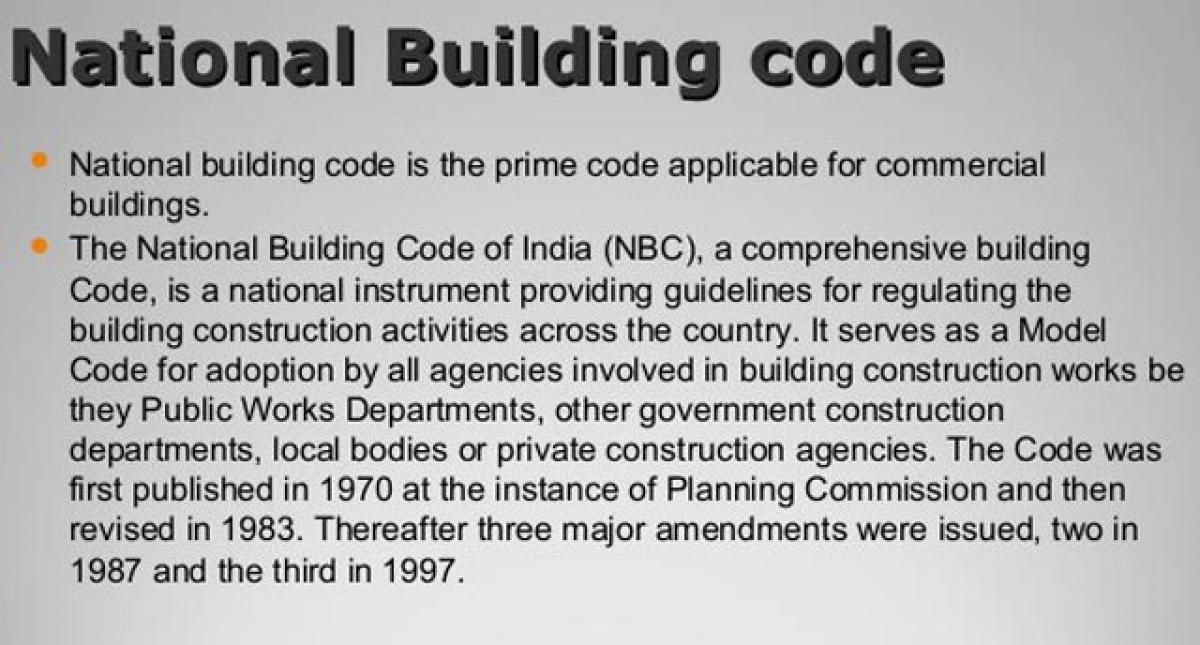Live
- GMR Airports Unveils AI-Powered Digital Twin Platform to Transform Airport Operations
- India poised to become leading maritime player: PM Modi
- Top Causes of Kidney Stones and How to Recognize Silent Symptoms
- India’s renewable energy capacity logs 14.2 pc growth at 213.7 GW
- Winter Session of Odisha Assembly adjourned sine die
- Biden calls Trump's tariff approach 'major mistake'
- After Drama Over Eknath Shinde’s Chief Minister Race, Maharashtra Cabinet Formation Faces New Tensions
- Egyptian FM, Blinken discuss recent developments in Syria
- Iran's supreme leader says Syria's developments result of US-Israeli 'plot'
- Elon Musk to Purchase $100 Million Luxury Mansion Next to Donald Trump's Mar-a-Lago, Report Reveals
Just In

The revised National Building Code, set to be unveiled later this year, will bring state-of-the-art and most contemporary version of the building code, dealing with futuristic developments, in line with the Narendra Modi government\'s emphasis on realty reforms.
The revised National Building Code, set to be unveiled later this year, will bring state-of-the-art and most contemporary version of the building code, dealing with futuristic developments, in line with the Narendra Modi government's emphasis on realty reforms.
The code, meant to help regulate building construction in the country, lays down a set of minimum provisions for buildings, designed to protect the safety of the public, with regard to structural efficiency, fire and earthquake hazards and health aspects, including environmental concerns.
It mainly contains administrative provisions, development control rules and general building requirements, stipulations regarding building materials, structural design and construction, plumbing services, landscaping, signage and outdoor displaying structures, etc.
The new code will provide detailed guidelines on construction management and come up with a comprehensive regulation and certification of structural safety of buildings with a series of improvements in the safety provisions to meet the challenges associated with the new trend of high rise buildings, including super tall structures and mixed use developments such as malls, multiplexes and integrated townships.
The new code will also give an overall direction for practical application of the provisions of different specialised aspects of spatial planning, design and construction of buildings, creation of services, proposing an integrated approach for utilising appropriate knowledge and experience of qualified professionals, right from conceptualization through construction and completion stages of a building project and during the entire life cycle.
The code complements the government's ambitious mission "Housing for All" that has a special focus on low cost affordable housing. The new code has detailed provisions for pre-fabricated construction for speedier construction with quality, to meet acute housing shortage. Further, to check project delays, the code focuses on streamlining procedures for real estate projects (SAPREP) through the single window concept.
It incorporates the suggestions mooted by the SAPREP panel constituted by the Ministry of Housing and Urban Poverty Alleviation, as part of Model Building Bylaws. The revised code has also renewed focus on integrated approach to get maximum benefit from the building and its services in terms of timely completion and cost- effectiveness with quality.
In line with the Modi government's mission "Accessible India, Empowered India", together with the "National Policy for Persons with Disabilities" and the "UN Convention on Rights of Persons with Disabilities", the code has for the first time made elaborate provisions for making buildings and public places accessible to millions of disabled and elderly persons. The code for barrier-free built environment will be applicable to all forms of public housing by government and private builders.
In view of the growing popularity of green/sustainable buildings, the new code promotes ecologically appropriate practices, use of eco-friendly construction materials and conventional and alternative technologies, reduction of pollution, protection and improvement of local environment and socio- economic considerations towards the creation of sustainable human settlements.
With a view to boosting sustainability, the building code has for the first time included provisions for glazing in buildings with respect to their effect on energy, visual (light) in the building and selection and manifestation of glass with respect to safety. It will also focus on energy conservation, use of solar energy and efficient lighting.
Keeping pace with the era of smart homes and smart cities, NBC 2016 has come up with a new chapter on "Information and Communication Enabled Installations" with general guidelines for planning and providing information and communication technology (ICT) services in the building and execution stages. Also, in view of the growing significance of property management, for the first time, a new chapter on "Asset Facility Management" has been added. The other new additions include Escalation and Moving Walks and solid waste management.
The building code, first formulated in 1970, and subsequently revised in 1983 and 2005, is implemented through municipal corporations, local urban bodies, public works departments and other construction departments and agencies. The new code, a revised version of the one released in 2005, will turn out to be a game changer in regulating building construction in line with the contemporary new trends and advancements in construction, together with new age reforms in the real estate and construction sector.
By Vinod Behl

© 2024 Hyderabad Media House Limited/The Hans India. All rights reserved. Powered by hocalwire.com







